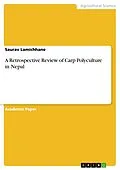Academic Paper from the year 2021 in the subject Agrarian Studies, grade: 3.84, , language: English, abstract: This paper is a retrospective review of Carp Polyculture in Nepal. Polyculture is an art and science of growing two or more compatible fish species in a pond to maximize production by taking advantage of different spatial distribution and feeding habits. Polyculture concepts rely on the complete utilization of various spatial niches and trophic of a pond to acquire a maximum production per unit area. Carp polyculture is the most common, popular, and successful aquaculture system in Nepal. Carp polyculture is the major aquaculture system contributing to more than 90% of total aquaculture production in Nepal. In 2018/19, total fish production, aquaculture, and productivity were 91,832 t, 70,832 t, and 4.92 t/ha, respectively, which is insufficient to fulfill the growing demand for fish in Nepal. Therefore, it is essential to increase production and productivity.
Autorentext
The author, Saurav Lamichhane is the son of Mr. Ganga Prasad Lamichhane and Mrs. Brinda Poudel. He was born on 30 September 1998 in Madi- 3, Chitwan, Nepal. He completed his school leaving certificate (SLC) education from Gyandarshan English Boarding School, Chitwan, Nepal in 2012. He got his Higher Secondary Education Board (HSEB) education from Orchid College in 2015. Then, he was enrolled in B.Sc. Fisheries program in the year 2015 at Agriculture and Forestry University, Chitwan. He had traveled to many places related to aquaculture and fisheries, farm, and offices. He had participated in "Leadership, Personality development, Motivational program, Data analysis, Climate change simulation programs." During his four years of an undergraduate program, he had involved in LEE (Learning Entrepreneurial Experience) and equipped with field-level experience in fisheries and aquaculture. He keeps his keen interest in research and development in breeding and aquaculture production.
